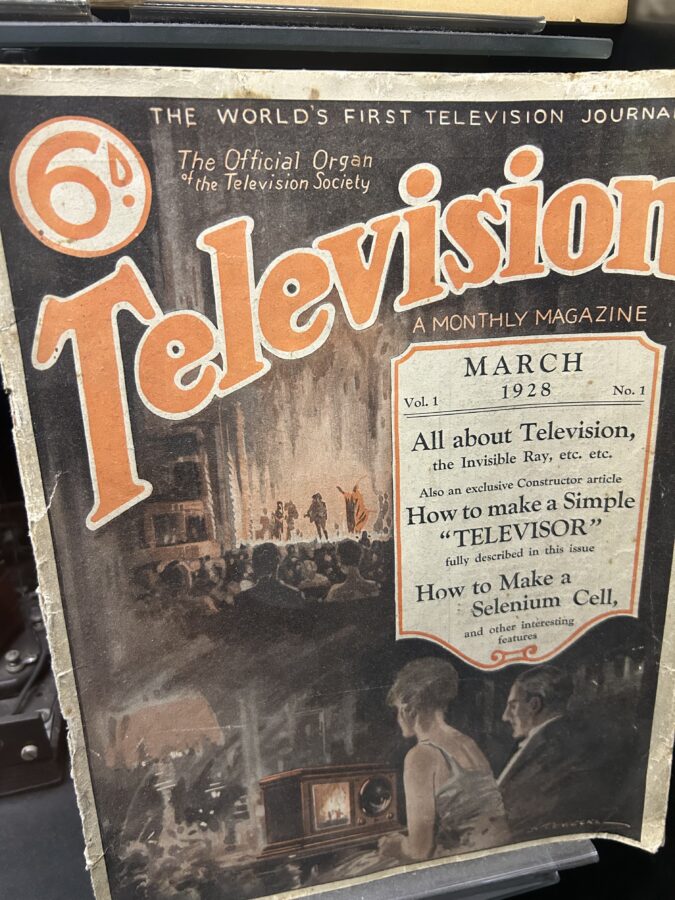Yesterday, I visited the Museum of Brands in London’s Notting Hill – an immersive journey through the evolution of consumer culture. Among the retro packaging, ration books and nostalgic jingles, one item stopped me in my tracks: the world’s first monthly television journal, published in March 1928 by the Television Society.
Almost a century old, this unassuming periodical was a pioneering concept – not just in television, but in content marketing. Long before SEO, social, or even regular broadcasting, it was building community, thought leadership, and niche authority.
So, if you’re working in digital or tech marketing today, there’s a surprising amount to learn from its pages. Let’s take a look…
1. Be the first to own the conversation
In 1928, television wasn’t even in people’s homes yet. Still, the Television Society launched a dedicated monthly journal, speaking directly to engineers, inventors and visionaries.
Content Marketing takeaway: If you create meaningful content in an emerging space before anyone else, you don’t just participate in the conversation – you own it.
Spot a trend early? Start publishing. Thought leadership favours the brave.
2. Speak to a hyper-niche audience
This wasn’t light entertainment. The journal was tailored for those deep in the weeds of television development – scientists, not spectators.
Content Marketing takeaway: Don’t dilute your message trying to please everyone. The more you can focus on your audience, the more relevant your content – and the more trust you build.
Use language, formats and topics that reflect your audience’s exact pain points and priorities.
3. Blend vision with practicality
The journal balanced big ideas (cutting-edge research) with tangible value (technical diagrams, experimental results).
Content Marketing takeaway: Great content doesn’t just inspire – it enables. Combine vision with usable tools.
Pair thought leadership with templates, guides or frameworks your audience can apply straight away.
Throwback Tip: “How to Make a Simple Televisor”
The very first edition of Television didn’t just explore “The Invisible Ray” – it included step-by-step instructions for building your own TV receiver at home. Imagine downloading ChatGPT and getting a soldering guide with it.
Content Marketing takeaway: The best content is both fascinating and functional. Empower your readers to take action – not just nod in agreement.
Your how-to content might be someone’s first hands-on experience with your solution. Make it count.
4. Build a community, not just a readership
As the “official organ” of the Television Society, the journal gave members a platform and a sense of identity.
Content Marketing takeaway: Content isn’t just output, it’s glue. Used well, it unites people around a mission or mindset.
Feature real voices. Share user stories. Let your content reflect the community you’re trying to cultivate.
5. Invest in long-form, high-quality content
This was serious stuff – it contained deep dives, not fluff. And it paid off: the journal became a credible, long-term reference point.
Content Marketing takeaway: Long-form, well-researched content builds authority and drives deeper engagement – especially in B2B or tech sectors.
Don’t fear detail. Your audience will thank you for not skimming the surface.
6. Create content that lasts
Printed in a pre-digital world, these journals had to be built to last – and they were. Today, they live on as archival records.
You can almost feel the permanence in the March 1928 cover – from the bold typography to the promise of “interesting features” like how to build a selenium cell. It was more than media, it was legacy.
Content Marketing takeaway: Good content shouldn’t expire after a few weeks. Create assets with longevity, not just quick wins.
Think evergreen. Think foundational. Think about what your audience will still value in five years.
7. Chronicle innovation
The journal didn’t just track TV, it became part of its story. It documented history as it unfolded.
Content Marketing takeaway: Don’t just react to industry changes, record them. Your brand’s content can help define your field.
Tell the story of your sector’s evolution and your place within it.
Want to put these content marketing ideas into practice?
Standing in front of that 1928 journal, I was reminded that content marketing isn’t new. What’s changed are the tools, not the principles. At its best, content is about insight, community and leadership. And those ideas? They’re as powerful now as they were 100 years ago.
At Bright Star, we help tech and digital brands turn big ideas into targeted content that earns attention – and keeps it. Whether you’re launching into a new niche or building community in an existing one, let’s talk.

